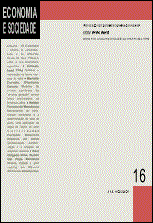Resumen
O artigo revê os chamados modelos de “terceira geração” de crises cambiais, com o intuito de discutir em que medida os elementos destacados como geradores das crises cambiais por essa literatura encontram-se presentes nas recentes crises latino-americanas, particularmente nas crises mexicana de 1994 e brasileira de 1999. O trabalho conclui que as evidências empíricas apontam para a robustez da literatura de “terceira geração” na explicação dos ataques especulativos ocorridos no Sudeste Asiático em 1997, com desempenho inferior no caso das crises latino-americanas recentes
Abstract
The paper reviews the so-called “third generation” models of currency crises. After presenting a few selected models from the literature, the paper discusses whether they contribute to the understanding of the recent currency crises in Latin America – in particular the Mexican crisis of 1994 and the Brazilian crisis of 1999. It is argued that the empirical evidence suggests that “third generation” models are more useful in the case of the Asian crises than in the Latin American case.
Key words: Currency crises. Third generation models. Latin America
Citas
ANDRADE, J. P., SILVA, M. L. F. Divergências e convergências sobre as crises cambiais. In: LIMA, G. T., SICSÚ, J., PAULA, Luiz Fernando de. (Org.).
Macroeconomia moderna – Keynes e a economia contemporânea. Rio de Janeiro: Editora Campus, 1999.
BAIG, T., GOLDFAJN, I. The Russian default and the contagion to Brazil. Rio de Janeiro: PUC. Departamento de Economia, mar. 2000. (Texto para Discussão, n. 420).
BLANCHARD, O., FISHER, S. Lectures on macroeconomics. London: MIT Press, 1989.
CALVO, G., MENDOZA, E. G. Rational contagion and the globalization of securities markets. 2000. Disponível em: <http://www.imf.org.>.
CANUTO, O. Mobilidade de capital e equilíbrio de portfólio. Economia e Sociedade, Campinas, n. 9, p. 1-47, dez. 1997.
________. A crise Asiática e seus desdobramentos. Econômica, 2001 (porvindouro).
CANUTO, O., CURADO M., GOMES, R. Finanças globais e flutuações macroeconômicas em economias emergentes. Revista de Economia Contemporânea, Rio de Janeiro, n. 5, p. 115-132, jan./jul. 1999.
________, FERREIRA, R. R. Assimetrias de informação e ciclos econômicos: Stiglitz é Keynesiano? Ensaios FEE, Porto Alegre, ano 20, n. 2, p. 7-42, 1999.
CHANG, R., VELASCO, A. Financial crises in emerging markets: a Canonical model. National Bureau of Economic Research Working Papers, n. 6.606, Jun. 1998. Disponível em: <http://www.nber.org>. Acesso em 13 set. 1999.
CORSETTI, G., PESENTI, P., ROUBINI, N. What caused the Asian currency and financial crisis. National Bureau of Economic Research Working Papers, n. 6.833, Dec. 1998. Disponível em: <http://www.nber.org>. Acesso em 13 set. 1999.
CURADO, M. Rigidez comercial, movimentos de capital e crise cambial. Campinas: Unicamp. Instituto de Economia, 2001. (Tese, Doutorado).
DIAZ-ALEJANDRO, C. Good-bye financial repression, hello financial crash. Journal of Development Economics, North Holland, v. 19, n. 1/2, Sept. 1985.
EDWARDS, S. Real exchange rates, devaluation and adjustment. London: MIT Press, 1989.
________. Interest rates, contagion and capital controls. National Bureau of Economic Research Working Papers, n. 7.801, Jul. 2000. Disponível em: <http://www.nber.org>. Acesso em 13 set. 2000.
EICHENGREEN, B., MUSSA, M., DELL’ARICCIA, DETRAGIACHE, E., TWEEDIE. A liberalizing capital movements: some analytical issues. Economic Issues (IMF), n. 17, p. 1-12, 1999.
FLOOD, R., GARBER, P. M. Collapsing exchange rates regimes: some linear examples. Journal of International Economics, n. 17, p. 1-13, Ago. 1984.
FLOOD, R., MARION, N. Perspectives on the recent currency crisis literature. National Bureau of Economic Research Working Papers, n. 6.380, Jan. 1998. Disponível em: <http://www.nber.org>. Acesso em 21 jan. 1999.
FOLEY, D. K. Financial fragility in developing economies. New York: New School of Economics, Jun. 2000. (Discussion Papers).
FONDO MONETARIO INTERNACIONAL – FMI. Estadísticas Financieras Internacionales (Vários números).
KAMINSKY, G. L., REINHART, C. M. The twin crises: the causes of banking and balance of payments problems. Feb. 1998. Disponível em: <http://www.nber.org>.
Acesso em 30 set. 1999.
KREGEL, J. The Brazilian crisis: frome inertial inflation to fiscal fragility. Working Paper, n. 294, Feb. 2000. Disponível em: <http://www.levy.org>. Acesso em 14 jun.
KRUGMAN, P. A model of balance of payment crises. Journal of Money, Credit and Banking, n. 11, p. 311-325, Aug. 1979.
________. What happened to Asia? 1998. Disponível em: <http://www.mit.edu>. Acesso em 14 jun. 1999.
MILGROM, P., ROBERTS, J. Information, assimmetries, strategic behavior and industrial organization. American Economic Review, Menasha, p. 184-193, 1987.
MISHKIN, F. S. Lessons from the Asian crisis. National Bureau of Economic Research Working Papers, n. 7.102, Apr. 1999. Disponível em: <http://www.nber.org>. Acesso em: 21 jan. 1999.
OBSTFELD, M. The logic of currency crises. National Bureau of Economic Research. Working Papers, n. 4.640, Feb. 1994. Disponível em: <http://www.nber.org>. Acesso em: 14 jun. 1999.
STIGLITZ, J. E., WEISS, A. Credit rationing in markets with imperfect information. American Economic Review, Menasha, v. 71, n. 3, p. 393-416, Jun. 1981.
A Economia e Sociedade utiliza a licença do Creative Commons (CC), preservando assim, a integridade dos artigos em ambiente de acesso aberto.


